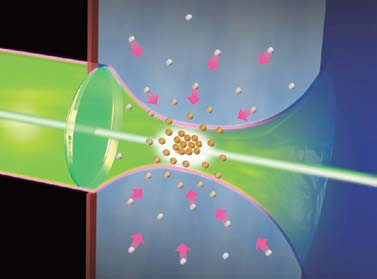Inside Lehigh’s biophotonics laboratory, Daniel Ou-Yang shines a green laser on tiny, fluorescently-labeled spheres of polystyrene suspended in a glass of water, and observes behavior that in humans would be called antisocial.
The spheres, measuring 60–100 nanometers, show no attachment for one another, no inclination to interact. Each particle is content to keep to itself.
Now Ou-Yang takes a stronger, infrared laser, aligns it collinearly with the green laser and shines it on the solution. The scene changes dramatically. Hundreds of particles that a moment earlier had shown no interest in each other now swarm into the micron-sized ellipse formed by the laser’s focal point.
Ou-Yang switches the infrared laser off and just as quickly the particles disperse. On and off he switches the laser, several times more, to watch the migration into, and the exodus from, the focal point of the laser.
Ou-Yang, professor of physics and associate director of Lehigh’s bioengineering program, calls the laser’s footballshaped focal point an “optical bottle.” He believes the bottle offers scientists and engineers a promising window to study the behavior of particles, and he has applied for a patent on his technique.
“By using light to create mechanical forces that can manipulate the physical behaviors of particles in surrounding media,” says Ou-Yang, “we think we have acquired a new and improved tool for studying particle-to-particle interactions in media. We can now calculate these interactions in situ, without needing to interrupt a process or remove the solution from a process.
“A better understanding of these interactions, coupled with the ability to manipulate the motions of the particles, is vital to industries that use nanoparticle-sized objects such as proteins, carbon nanotubes, pigments, gold particles. If we can attach these objects to the polystyrene spheres, or if we can manipulate them like we control the spheres, the processes of these industries could be refined to improve efficiency.
Another potential application is diagnostics. If we can bind proteins, which are smaller than the latex particles, to those particles, we might achieve greater sensitivity in detecting those proteins.”
Starting with tweezers
Ou-Yang began a dozen years ago to explore the applications that become possible when light is harnessed to produce mechanical forces. Using a laser tool known as optical tweezers, he learned that, by focusing a laser beam through an objective lens in an optical microscope, he could manipulate individual micron-sized dielectric objects. Using mirrors to steer the laser beam before it entered the microscope, he was able to oscillate the objects and measure the micromechanical properties of the materials in which the objects were embedded.
In 2003, Ou-Yang’s group became one of the first to use optical tweezers to study the interior of an endothelial cell noninvasively, without introducing foreign particles into or around the cell. Achieving a resolution of 0.5 nm, OuYang uncovered new information about the rigidity of the cytoskeletons of live cells. He began quantitatively mapping the intracellular mechanical properties of the cells and determining how they are affected by extracellular physical or chemical influences.
Ou-Yang has utilized optical tweezers in several projects with engineers. At Lehigh, he works with Prof. Samir Ghadiali of mechanical engineering and mechanics to evaluate the mechanical responses of epithelial cells in the deep lung to the forces imposed by ventilating machines.
Working with Shu Chien, director of the Whitaker Institute of Biomedical Engineering and professor at UC-San Diego, Ou-Yang uses a tweezer-based cytorheometer to study the mechanisms by which biological cells sense and respond to their external mechanical environment.
Ou-Yang also collaborates with Miriam Rafailovich, director of the Garcia Center for Polymers at Engineered Interfaces at SUNY-Stony Brook. They are seeking to identify the critical parameters involved in engineering the mechanical properties of the extracellular matrix to control cell functions.
A bottle that harnesses light
While optical tweezers are ideal for studying micron-sized objects, the optical bottle is better suited for studying nanoparticles, says Ou-Yang.
“You can’t trap individual nanoparticles,” he says, “but you can study their interactions inside the optical bottle by imparting a mechanical force with light. The question is how much radiation you need.”
Determining how nanoparticles interact with each other, and with the light source, says Ou-Yang, requires deduction.
“We can deduce the nature of these interactions by measuring the extent to which the particles fill the bottle; this suggests particle-to-particle attraction. The reverse is true; a bottle not filled with many particles suggests a repulsion or lack of attraction.”
When large numbers of particles crowd into the bottle, says Ou-Yang, the electrical field of the infrared laser induces the formation of an electric dipole in each particle. The dipoles, in turn, interact with each other to form secondary structures. Ou-Yang plans to introduce a third laser to study the formation of these structures.
“The key here is that you can manipulate colloidal stability, either mechanically or optically, to change the natural state. Whether you end up with a magnetic, electrical or optical bottle, you are dealing with the same phenomenon.
“In a magnetic bottle, a high magnetic field confines the plasma used for nuclear fusion. In an electrical bottle, an electrical field confines dielectric particles to a localized region. In an optical bottle, light triggers or alters the dynamics of the interactions of colloidal nanoparticles, allowing us to study and analyze these interactions or control their transport behavior for manipulation purposes.
“The overriding question remains: How do you harness the mechanical force from photons and what do you do with that force in different regimes of colloidal science and engineering?”

